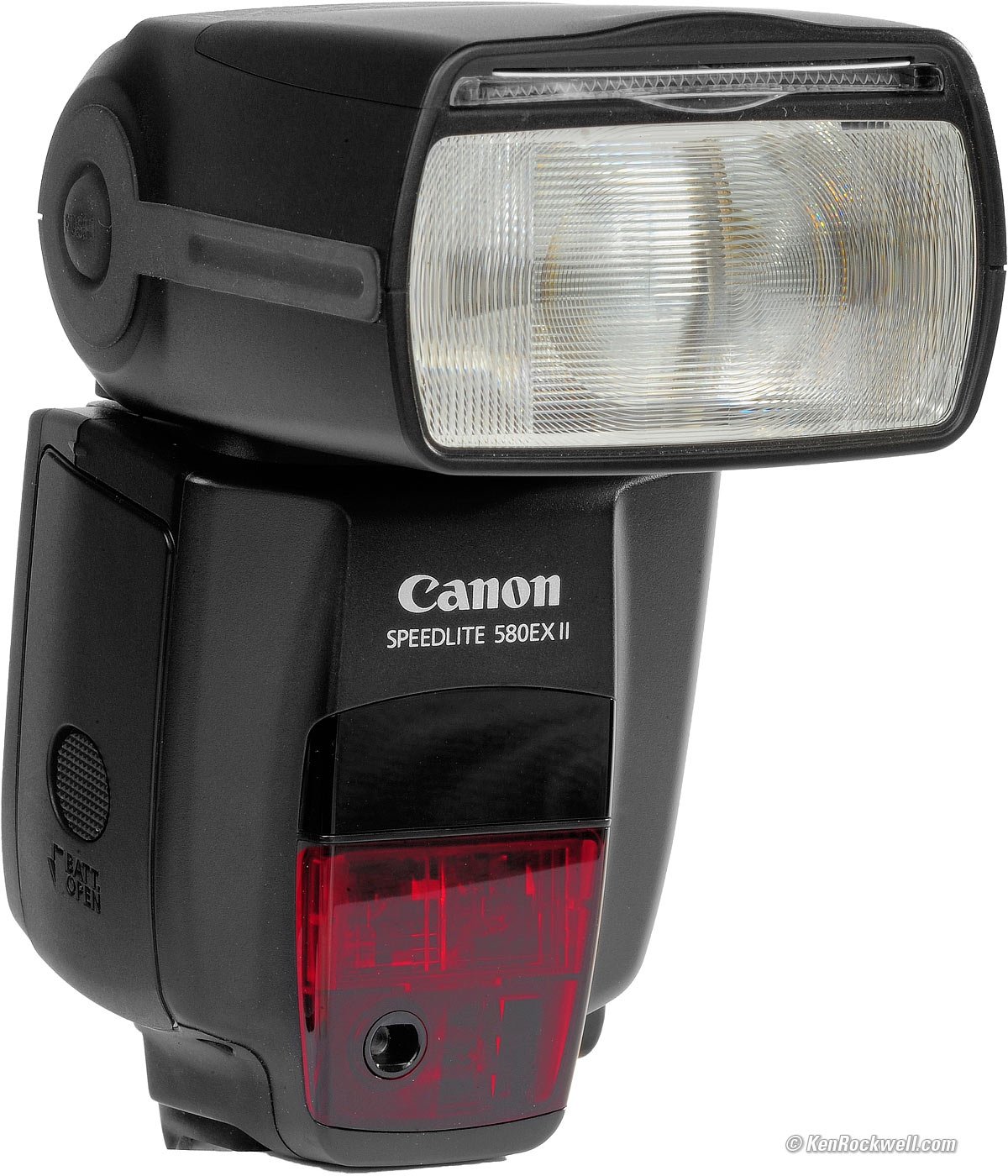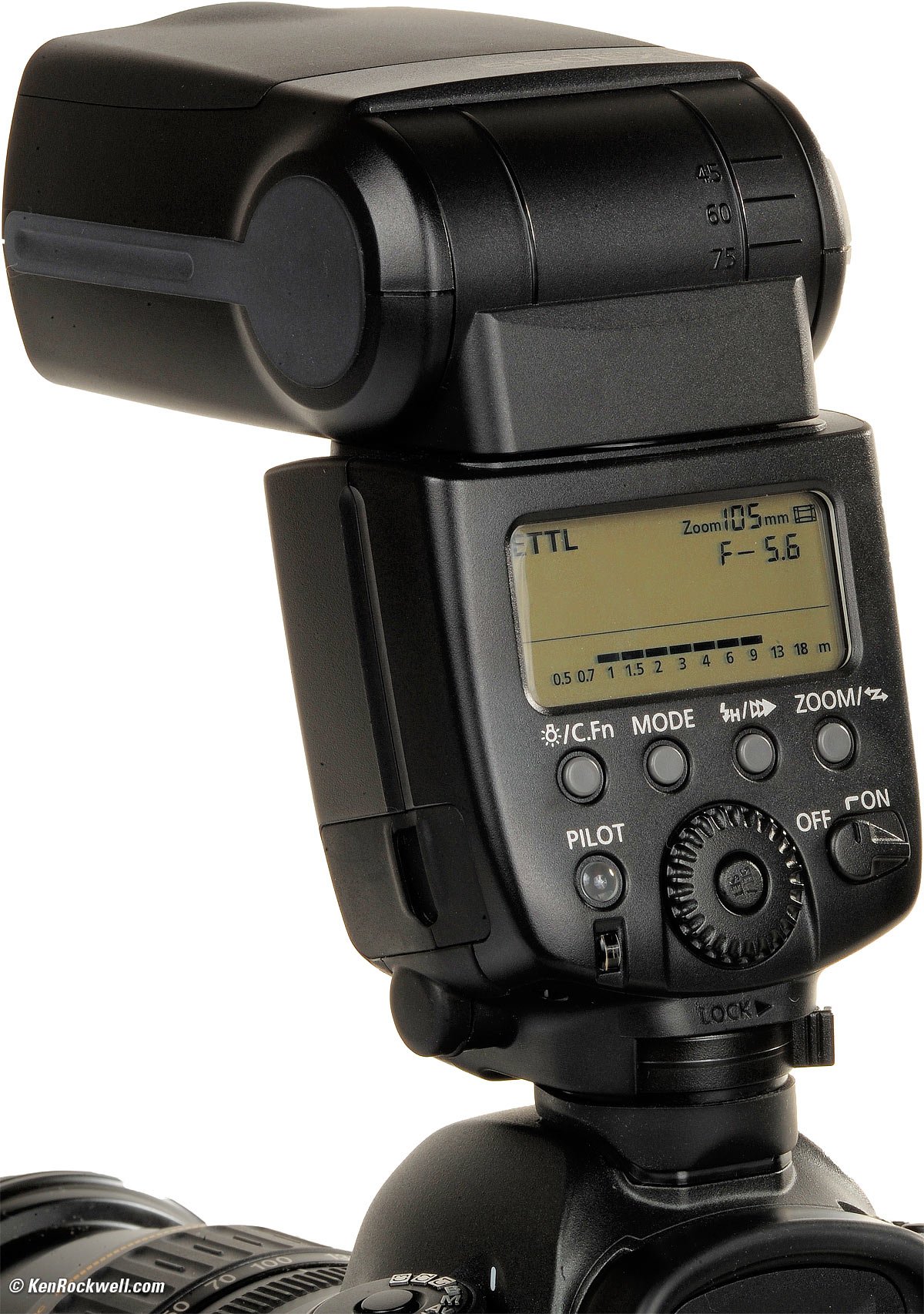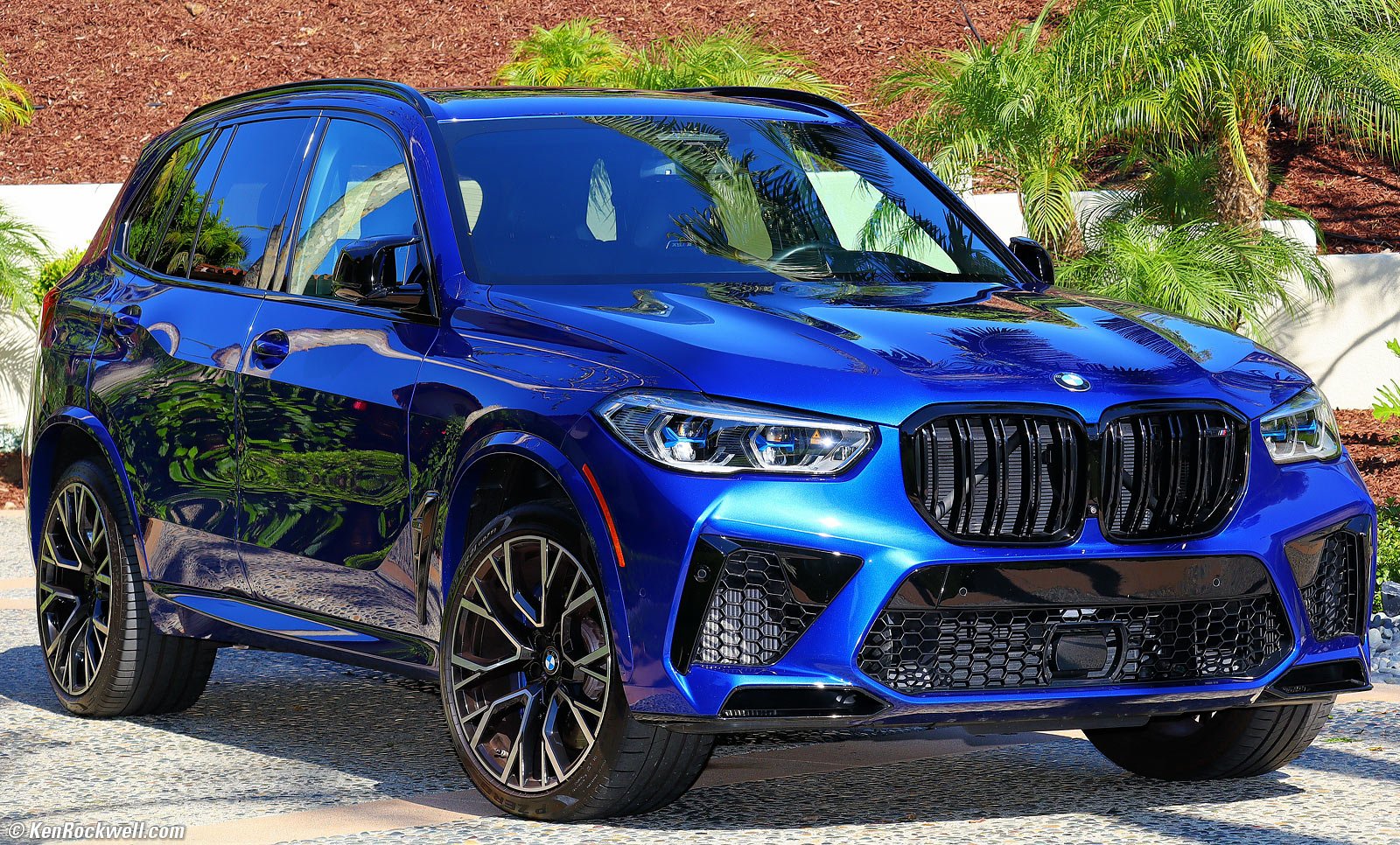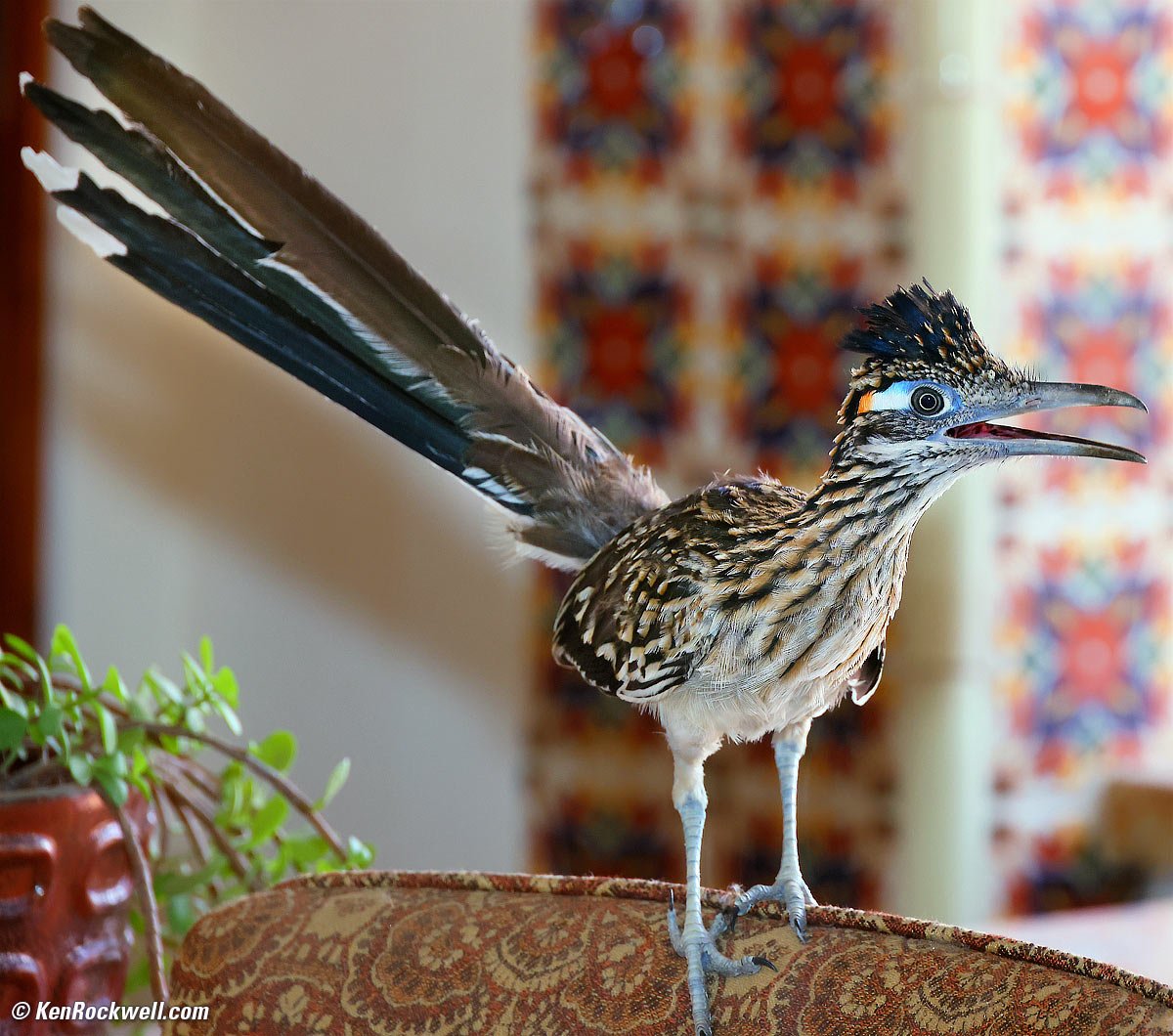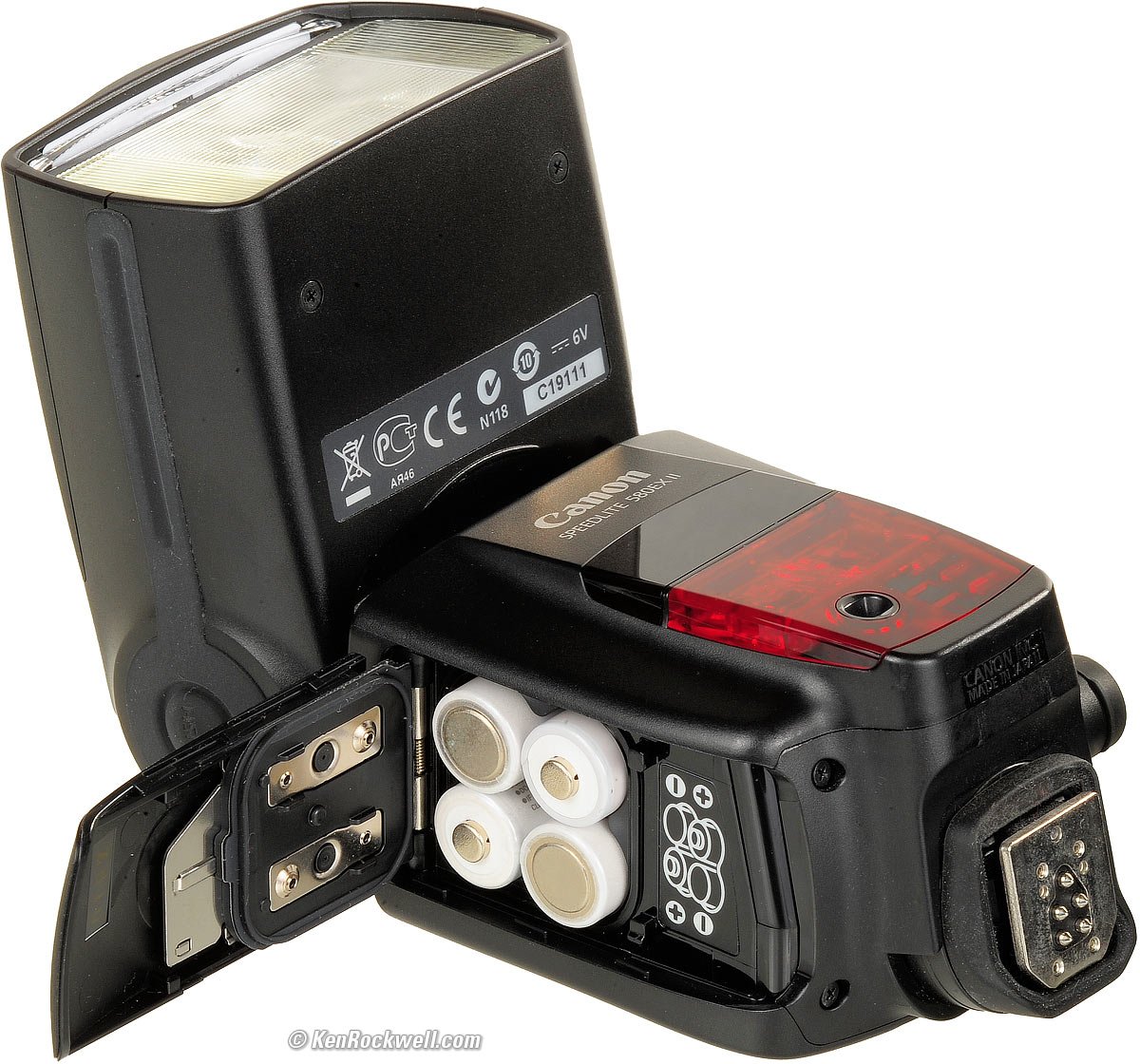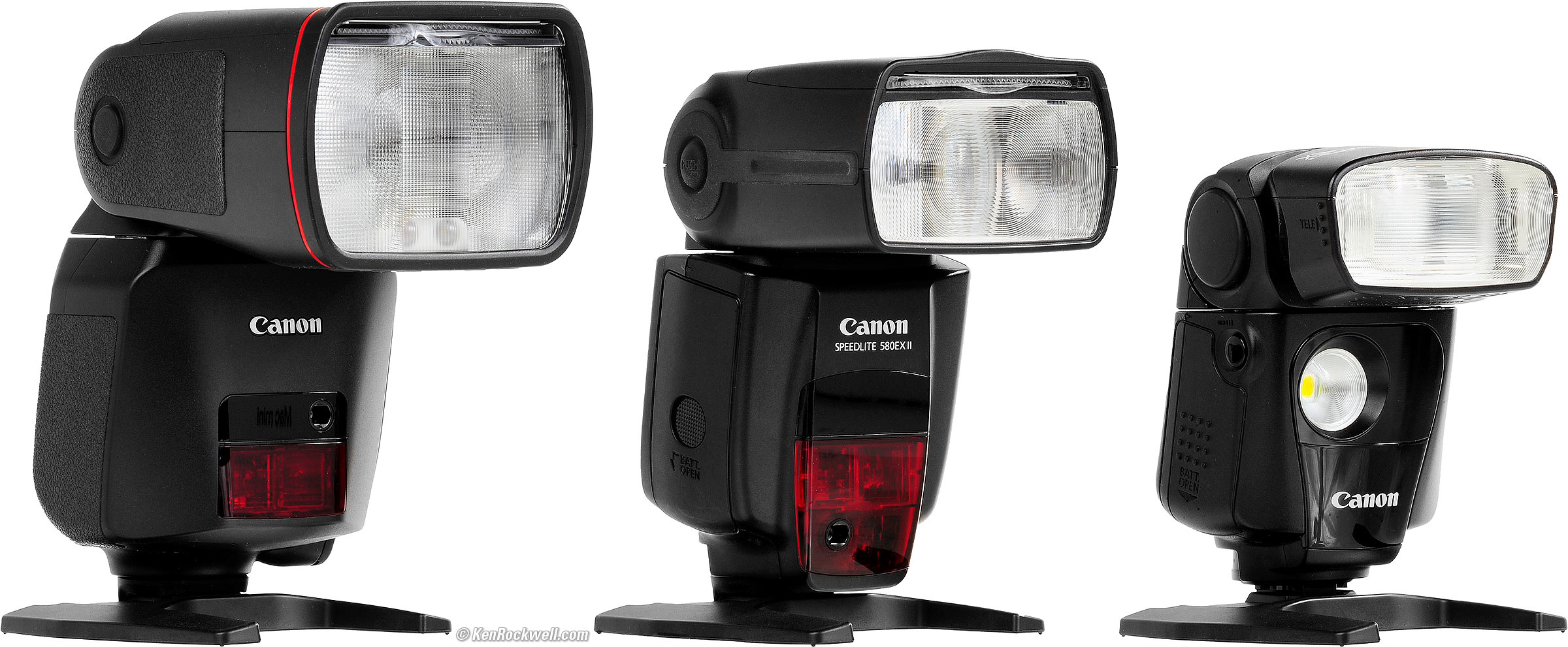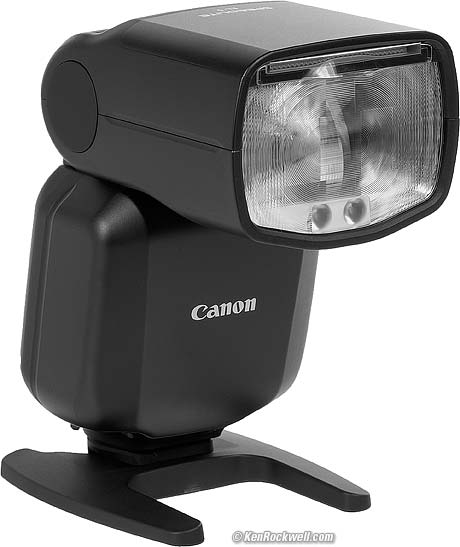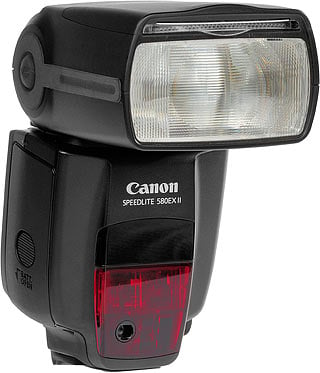Canon 580EX II
Professional Speedlite Flash
Sample Image Intro Compatibility Specs
Performance Compared User's Guide
Canon 580EX II (18.1 oz./513.2g with 4-AA eneloop, 24-105mm zoom head with 14mm wide panel and catchlight card, 4.1 second measured recycle time, measured GN 27m/90' at 35mm or 44m/143' at 105mm, rated GN 36m/118' at 35mm or 58m/190' at 105mm, about $85 used if you know How to Win at eBay). bigger. I got mine at this link directly to them at eBay; you also can get them at Amazon.
This all-content, junk-free website's biggest source of support is when you use those or any of these links to approved sources, when you get anything, regardless of the country in which you live. It helps me keep adding to this free website when you get anything through these links — but I receive nothing for my efforts if you take the chance of buying elsewhere. Buy only from the approved sources I use myself for the best prices, service, return policies and selection. Thanks for helping me help you! Ken.
August 2023 Canon Reviews Canon Flash Canon Lenses All Reviews
Phil Steele's Advanced Off-Camera Flash course
Canon 580EX II. bigger.
Sample Images top
Sample Image Intro Compatibility Specs
Performance Compared User's Guide
BMW X5M Competition, 9:34 AM, Tuesday, 22 August 2023. Canon EOS R100, Canon 580EX II flash for fill, Canon RF-s 55-210mm IS STM at 66mm at f/8 at 1/160 at Auto ISO 100, -1 stop exposure compensation (LV 13.4), Perfectly Clear (now sold as Radiant Photo). bigger or full 24 MP resolution.
Get close enough and the 580EX II has no problem keeping up with 12 FPS bursts from the EOS R5:
Visiting Roadrunner (shot through window), 10:55 AM, 13 August 2020. Canon EOS R5, Canon RF 24-240mm IS at 183mm at f/7.1 at 1/200 at Auto ISO 1,600 (LV 9¼), Canon 580 EX II flash, Perfectly Clear. bigger, full 45MP resolution or camera-original © JPG file.
Introduction top
Sample Image Intro Compatibility Specs
Performance Compared User's Guide
|
I buy only from these approved sources. I can't vouch for ads below. |
The 580EX II is a superb state-of-the art professional flash differing only in not having radio control from the $500 600EX II RT.
The Canon 580EX II was Canon's top professional flash from 2007 until it was replaced by the 600EX-RT in 2012. It works perfectly with all Canon EOS cameras, both 35mm and digital.
This 580EX II has the same size, weight and power and does all the same things as the 600EX for one-quarter the price today, lacking only the radio controlled features. If you use third-party wireless radio control devices (see Phil Steele's excellent tutorials), you can use this 580EX II to do exactly the same radio triggering! This 580EX II of course does all the usual optical and IR remote triggering and control.
The 580EX II is powerful, fast, flexible and quiet, and today sells used for next to nothing. If you're not using radio control and are using it on-camera or with optical remote wireless control, there isn't anything better. The 600EX series does recycle a little faster, but the power is the same (bolstered only by a slightly better reflector system at the longest zoom settings) and this 580EX II recycles super-fast. This 580EX II recycles in just 4.1 seconds from a full-power dump, and does it silently. It usually recycles instantly.
This 580EX II has a superior dedicated backlit LCD, making it easier to read than the dot-matrix displays of the 600EX.
There's a flip-out ultra-ultrawide/fisheye diffuser panel and a pop-up catchlight card.
It comes boxed with a padded nylon case, a little stand and printed manuals when new.
I use my 580EX II when I need power, which is when I'm using it for daylight fill-flash at longer distances with longer lenses. Any of the smaller flashes are fine for every other use, and even for daylight fill if you're not too far away.
The 580EX II is even weather-resistant!
New
Compared to the original 580EX:
 Greatly improved weather-sealed lever-based shoe locking system replaces the old screw-down ring that never worked.
Greatly improved weather-sealed lever-based shoe locking system replaces the old screw-down ring that never worked.
 Weather resistant.
Weather resistant.
 20% faster recycling.
20% faster recycling.
 Silent recycling.
Silent recycling.
 Restores the classic non-TTL "A" exposure mode for ancient mechanical cameras, as well as a clever non-TTL A mode that sets itself to your camera's ISO and aperture.
Restores the classic non-TTL "A" exposure mode for ancient mechanical cameras, as well as a clever non-TTL A mode that sets itself to your camera's ISO and aperture.
 Better battery door.
Better battery door.
 Rotary lever ON/OFF switch replaces the sliding power switch of the original 580EX.
Rotary lever ON/OFF switch replaces the sliding power switch of the original 580EX.
 PC sync terminal to connect to radio triggers.
PC sync terminal to connect to radio triggers.
 New ST-E2 Wireless Transmitter, CP-E4 external battery pack holds 8 AA cells, OC-E3 remote hot-shoe cord and SB-E2 flash bracket all introduced along with the 580EX II.
New ST-E2 Wireless Transmitter, CP-E4 external battery pack holds 8 AA cells, OC-E3 remote hot-shoe cord and SB-E2 flash bracket all introduced along with the 580EX II.
Good
 Loads of power.
Loads of power.
 Fast and silent recycling; keep shooting and the 580EX II keeps blasting out the power with no waiting.
Fast and silent recycling; keep shooting and the 580EX II keeps blasting out the power with no waiting.
 Built in infra-red autofocus illuminator.
Built in infra-red autofocus illuminator.
 The Infra-red low-light AF illuminator covers many AF sensors, not just the center.
The Infra-red low-light AF illuminator covers many AF sensors, not just the center.
 Wireless (IR) flash control.
Wireless (IR) flash control.
 AUTO EXPOSURE OK light.
AUTO EXPOSURE OK light.
 Catchlight panel.
Catchlight panel.
 First-world made-in-Japan quality.
First-world made-in-Japan quality.
Bad
Nothing; this is a top-notch flash at a bargain price used today.
Missing
 No more dedicated Master/Slave switch.
No more dedicated Master/Slave switch.
 No radio control, so use third-party wireless radio control devices or use the optical wireless system.
No radio control, so use third-party wireless radio control devices or use the optical wireless system.
Compatibility top
Intro Compatibility Specs Performance
Compared User's Guide Recommendations More
It works perfectly with all Canon DSLRs and all Canon 35mm EOS cameras.
Even if you're using ancient "B-type" 35mm EOS cameras from the 1980s or 1990s like the primitive EOS 620 then TTL, flash exposure compensation, flash bracketing, stroboscopic flash, rear-curtain, external manual metering and wireless manual slave all work great!
What doesn't work with the oldest B-type 35mm cameras is flash exposure lock, high-speed sync, TTL wireless flash or remote lighting ratio setting with wireless flash — things I doubt anyone will miss with a 1980s camera. No worries; the newest 35mm cameras you might actually want to shoot like the EOS 3 and EOS 1V are all the newest type A cameras on which all the features work perfectly.
Specifications top
Sample Image Intro Compatibility Specs
Performance Compared User's Guide
Power at ISO 100
Zoom Setting, Full-frame (APS-C equiv.) |
Rated GN,
Meters |
Rated GN,
Feet |
Measured GN,
Meters |
Measured GN,
Feet |
14mm (9mm) |
15 |
49 |
12 |
40 |
24mm (15mm) |
28 |
92 |
22 |
71 |
35mm (22mm) |
36 |
118 |
27 |
90 |
50mm (31mm) |
42 |
138 |
31 |
101 |
105mm (65mm) |
58 |
190 |
44 |
143 |
Manual Power Levels
Full to 1/128 in third stops.
It allows you to set any third stop, even between full and half.
Recycling Time (from full-power dump)
Rated 5 seconds with alkaline cells.
Measured 4.1 seconds with eneloop.
See also measured recycling time.
Full-Power Flashes (rated)
100 with alkaline cells.
Zoom Head
24-105mm with a 14mm flip-down diffuser.
Smart enough to recognize cropped digital cameras and set itself accordingly.
Bounce
-7º to 90º vertical.
±180º left and right.
AF Illuminator
Yes, multi-zone infra-red.
Wireless IR Control
Optical IR transmission system.
Works as a slave or as a transmitter.
4 channels.
3 slave groups: A, B or C.
Wireless Radio Control
None.
LCD
Custom display (not dot-matrix).
Green LED backlight.
Power
4 AA cells, alkaline, Ni-MH or disposable lithium.
While Canon originally recommended throw-away AA/R6 lithium cells, later Canon realized that they can vet very hot at high shooting loads and stopped suggesting them. More at User's Guide.
Optional CP-E4 external battery pack holds 8 AA cells.
Rear, Canon 580EX II. bigger.
Power Saving
Yes, goes to sleep after a few minutes of non-use.
Size
3.0 x 5.4 x 4.6 inches, WHD.
76 x 137 x 117 millimeters, WHD.
Weight
Measured 18.105 oz. (513.25g) with 4-AA eneloop.
Rated 14.3 oz. (405g) empty.
Quality
Made in Japan.
Announced
22 February 2007, along with the 1D Mk III.
Included
Flash.
Nice padded nylon case.
Little table stand.
Printed manuals.
Price, U. S. A. specifications top
August 2023
About $85 used if you know How to Win at eBay.
September 2022
About $90 used if you know How to Win at eBay.
March 2021
About $100 used if you know How to Win at eBay.
August 2020
About $110 used if you know How to Win at eBay.
August 2018
About $125 used if you know How to Win at eBay.
Performance top
Sample Image Intro Compatibility Specs
Performance Compared User's Guide
Power at ISO 100
Zoom Setting, Full-frame (APS-C equiv.) |
Measured GN,
Meters |
Measured GN,
Feet |
Rated GN,
Meters |
Rated GN,
Feet |
14mm (9mm) |
12 |
40 |
15 |
49 |
24mm (15mm) |
22 |
71 |
28 |
92 |
35mm (22mm) |
27 |
90 |
36 |
118 |
50mm (31mm) |
31 |
101 |
42 |
138 |
105mm (65mm) |
44 |
143 |
58 |
190 |
Slightly better than most flashes from Japan for at least the past 40 years, actual power is only about 0.8 stops less than rated, rather than a full stop as usual.
Recycling Time
4.1 seconds at full power.
It usually recycles instantly in TTL mode; only if you draw full or half power will you have to wait at all.
At half-power, it takes only 0.8 seconds for the ready light, and at 1/2 -0.7 (a.k.a. 1/3.2) or 1/4 or less the ready light stays on.
These are actual measured recycling times with real AA eneloop cells.
Ergonomics
The 580EX II is very easy to use. Canon has designed it well, everything is obvious except for the custom functions. Just tap the buttons and things happen directly and immediately; there are no menus.
The green LED backlight requires you press the left-hand LIGHT button. Sadly it doesn't turn on when you hit the camera's LIGHT button.
It's completely silent as it recycles, and just a quiet "tick" as it fires.
The battery door is tough and easy to use, and the battery polarity drawing is big and bold.
It has a good lock on the locking foot; a very advanced, solid and easy to use design.
AF Illuminators
Thank goodness the 580EX II has a real red IR AF illuminator, and it covers many sensors depending on what lens you're using. It's more than just one beam.
It doesn't have to use the foolish flash pops that lesser flashes like the 320EX have to do.
Exposure
Flash exposure is controlled by the camera. Different flashes will give the same results, with the only difference being if they have enough power and if they are ready to shoot fast enough.
Compared top
Sample Image Intro Compatibility Specs
Performance Compared User's Guide
Canon EL-1, 580EX II and 320EX Flashes Compared. bigger.
(roughly to scale—>) |
|||
Full-power GN at 24mm* |
70' / 22m |
71' / 22m |
67' / 20m |
Full-power GN at 50mm* |
105' / 31m |
101' / 31m |
80' / 24m |
Full-power recycling* |
0.9s |
4.1s |
2.4s |
Battery |
4 AA |
4 AA |
|
Remote Control |
Radio only |
Optical only |
Optical only |
Txmttr and/or Slave |
Txmttr or Slave |
Txmttr or Slave |
Slave only |
Foot |
Multi-Function only |
Standard 5-pin |
Standard 5-pin |
Works with |
Only the newest cameras since about 2021 with the "Multi-Function Shoe." | Just about every EOS camera, digital or 35mm, made since the late 1990s. | |
Infrared AF Illuminator |
No (uses white LED) |
Yes |
No |
White LED |
Yes |
No |
Yes |
Weight w/battery, oz.* |
20.7 oz. |
18.1 oz. |
13.1 oz. |
Weight w/battery, g.* |
586 g. |
513 g. |
373 g. |
Made in |
Taiwan |
Japan |
Taiwan |
Introduced |
2022 November 02 |
2007 February |
2011 February |
Gone by |
current |
2012 |
2017 |
Price, 03/2021 |
n/a |
About $100 used if you know How to Win at eBay. |
About $65 used if you know How to Win at eBay. |
Price, 09/2022 |
n/a |
About $90 used if you know How to Win at eBay. |
About $50 used if you know How to Win at eBay. |
Price, 08/2023 |
About $85 used if you know How to Win at eBay. |
About $50 used if you know How to Win at eBay. |
* Actual measured values.
These all take the same pictures, and have surprisingly similar maximum power outputs at wide settings. The lens systems of the bigger flashes give them more power at longer focal lengths as they're better able to focus the light.
The 580EX II has the same high power as this EL-5, while the EL-5 recycles over four times as fast.
The 320EX is much smaller, and impressively has as much maximum power (and therefore range) as the the EL-5 at the 24mm setting. At long settings the bigger flashes have more-focussed zoom heads for longer range.
All three can shoot bursts at lower power at 20 FPS; the difference is how many frames each can shoot before it loses steam.
Compared to the 600EX-RT (2015~)
The 600EX-RT is mostly the same with slightly faster recycling and adds radio control to optical control. It's the same size, weight and has the same power, although it does have an improved reflector system that can zoom longer so the specifications make it seem more powerful.
I prefer the custom LCD of the 580EX II to the dot matrix LCD of the 600EX. The dedicated icons and numbers are much easier to read on the 580EX than the grainy dot-matix representations on the 600EX.
Compared to the 430EX III RT (2015~)
The 430EX III RT is smaller, lighter, about 2/3 of a stop less powerful and adds radio control. It is a marvelous flash with ultra fast recycling and loads of features. It works as an optical slave, but can't work as an optical commander as the 580EX II can.
Overall the 430EX III RT is also a marvelous flash, just that it costs twice as much new as the 580EX II used.
Compared to the 430EX II (2008~2016)
The 430EX II is a marvelous flash with near-instant and silent recycling and loads of power and features. It has only a half-stop less measured power and potentially faster recycling than the 580EX II.
The 430EX II lacks a catchlight card, as do all the 320/420/430 flashes except for the newest 430EX III RT.
The 430EX II is just about as good once you get it set up, just with sloppier controls and no catchlight card. If you can use a business card and rubber band as pros have been doing for decades as a catchlight card, the 430EX II is a great flash, just harder to set since it has two plus/minus buttons instead of a rear dial.
Compared to the original 580EX (2004-2008)
See also What's New.
The original 580EX has noisier charging circuitry with slightly longer recycling times. It has a plastic foot with an crummy locking ring that never works. It has an EL backlight versus the green LEDs of the new 580EX II. The original 580EX is not weather sealed.
Compared to the 320EX (2011-2017)
The Canon 320EX is a small, simpler flash. It works well for action and fill-flash.
For general use where I'm not shooting a wedding, news, sports or portraits all day, I use my Canon 320EX because it's less to carry and does the same thing.
The small 320EX has almost as much power at the 24mm setting, 2/3 of a stop less power at 50mm but 1-2/3 stops less power at the 105mm setting because the 320EX lacks the big zoom reflector system of the larger flashes. The 320EX is great for just about anything unless you're using long lenses for fill outdoors in daylight, for which the 580EX II is superior.
The 320EX lacks an AF illuminator.
The 320 EX has a simpler manual 24~50mm zoom head and no catchlight or ultrawide panels.
The 320EX has a unique built-in remote shutter release for use with some Canon cameras.
For general fill use, I prefer the smaller size of the 320EX. It has plenty of power and ultrafast recycling, while I grab my 580EX II if I'm shooting a dedicated event or need powerful daylight fill with long lenses.
Canon 580EX II User's Guide top
Sample Image Intro Compatibility Specs
Performance Compared User's Guide
See also Canon's 580EX II user's manual and Phil Steele's Advanced Off-Camera Flash course.
Power Sources
I use 4 rechargeable AA eneloop cells. They don't run down if left unused, and always recycle strong and fast.
The 580EX II works fine even if the eneloop are nearly dead, testing 10% or less on my ZTS tester.
I wouldn't use throw-away alkaline cells unless I was in a pinch - but I always carry a spare set of charged eneloop in my bag.
Canon stopped recommending lithium throw-aways when they realized they got too hot with heavy pro use. Lithium are great if you're traveling super light and want to bring a few sets of these cells on a long trip where you won't be able to charge them, or if you want to be able to leave a set in the flash and have them still fresh and ready to go ten years from now, but for all other uses, use eneloop.
Flash Exposure Compensation
Set on your camera, or just tap the center SEL/SET set button, spin the dial, and press SEL/SET again.
You can set C.Fn 13 next to let you just turn the dial at any time to change the flash exposure compensation.
Custom Functions
You need this table to decode them. Hold the C.Fn button a few seconds, turn the dial to select which function to set, tap the SEL/SET button so the setting blinks and then change it with the dial. Tap SEL/SET again to save it (it stops blinking), and tap MODE to exit the settings.
Set these once now and forget them.
These default to 0. I leave these all at 0 except as noted. Set them any way you like.
| 0: Distance Units | 0: Meters. 1: Feet. |
| 1: Auto Power Off (dead battery saver) | 0: Yes. 1: No (batteries run down if you put it away and the power switch gets knocked to ON. |
| 2: Modeling Flash | 0: Use depth-of-field preview button. 1: Use test-firing button. 2: Use either button. 3: OFF. |
| 3: Flash Exposure Bracketing (FEB) auto cancel | 0: Yes. 1: No. |
| 4: Flash Exposure Bracketing (FEB) sequence | 0: 0 > — > +. 1: — > 0 > +. |
| 5: Flash Exposure Mode | 0: E-TTL/E-TTL II. 1: TTL (for old 1980s and 1990s cameras). 2: Non-TTL Auto exposure, set by flash's own sensor with aperture and ISO read automatically from the camera (see next section) 3: Non-TTL Auto exposure mode with manual setting of ISO and aperture at the flash (see next section). |
| 6: Quick Flash Mode (Pilot light turns green even if not fully recycled; this means you can shoot with perfect exposure at most lower power settings. This works in TTL and Manual mode at 1/4 power and below when shooting sequences.) | 0: No. 1: Yes (I use this, but don't get confused because the green ready light now means it's less charged than the default red one!). |
| 7: Test Firing with Auto Flash (sets the power level you get in TTL mode when you press the PILOT (test) button) | 0: 1/32. 1: Full power. |
| 8: AF illuminator | 0: Yes. 1: No. |
| 9: Auto Zoom for Sensor Size | 0: Yes. 1: No. |
| 10: Slave auto power-off timer | 0: 1 hour. 1: 10 minutes. |
| 11: Time during which the slave’s auto power off can be canceled by the master | 0: 8 hours. 1: 1 hour. |
| 12: Flash recycle with CP-E4 external battery pack | 0: Flash and external power pack. 1: External power pack. |
| 13: Exposure Compensation | 0: Tap SEL/SET and turn dial. 1: Just turn dial. |
"External Flash Metering" Mode
I wouldn't use this with modern cameras.
This mode measures exposure with a sensor on the front of the flash. It is not measured through the lens (TTL) in-camera when set this way, it's measured "externally" at the flash itself.
Canon calls this the "E" mode as it comes up on the LCD as you press the MODE button.
This mode is only available if you set C.Fn 05 = 2 (above) to change the ETTL mode to the E mode.
Once set this replaces the E-TTL mode with the E mode. You have to set C.Fn. 05 back to 0 to return to the usual E-TTL mode; the two don't come up in sequence as you press the MODE button.
In this mode the camera magically communicates its aperture and ISO to the flash so the flash's sensor can calculate exactly how much light to use.
Non-TTL Auto mode for use with ancient mechanical cameras
Canon calls this the "E M" mode as it comes up on the LCD as you press the MODE button. This stands for External Manual Flash Metering, meaning that the exposure is controlled automatically by a sensor on the front of the flash (not in the camera). You have to set your ISO and aperture on the flash manually so it can calculate the exposure.
This is the same as the traditional 1970's non-TTL "A" mode.
Set C.Fn 05 = 3 (above). Once set this replaces the E-TTL mode with the E M mode. You have to set C.Fn. 05 back to 0 to return to the usual E-TTL mode; the two don't come up in sequence as you press the MODE button.
You now have to set the flash to your camera's or film's ISO (it works from ISO/ASA 25~1,600) and your camera's aperture (f/1 to f/90) manually, and you have to use the camera's Av or M mode to use a fixed aperture. Set these on the flash by selecting the E M mode by tapping the MODE button, then tap the SEL/SET button once or twice until the ISO or aperture blink, spin the dial to select, then tap SEL/SET again to set.
Of course you can just use manual flash mode with old cameras as well.
Sleep (Battery Saving) Mode
By default it goes to sleep after a few minutes of non-use. If it's asleep, tap either the shutter, the PILOT button or turn it off and back on. It ignores its other buttons while sleeping.
Wireless Control
See also Canon's 580EX II user's manual and Phil Steele's Advanced Off-Camera Flash course.
Recommendations top
Sample Image Intro Compatibility Specs
Performance Compared User's Guide
This 580EX II flash is for hard-core outdoor fill-flash, sports and portrait work.
The only reason not to use the 580EX II is if it's too big. I usually use my Canon 320EX since it does the same thing (make light) and weighs less. Features are fine, but I just want the flash to fire when I take a picture. I don't use any of the remote features or light modifiers. For most people, the mid-size 430EX III RT is also a perfect fit, too. The smaller flashes are great for when the flash is pointed directly at the subject. The 580EX II's extra power is needed if you're using bounce, diffusers or other light modifiers because they lose most of the light.
I use my 580EX II when I'm using longer lenses and/or shooting in daylight at longer distances. For most conditions the 320EX is more than enough.
Use eneloop rechargeable batteries. They don't run down when you don't use them, and are loaded with power for fast recycling even if you haven't used your flash in months.
If you've found the time, effort and expense I put into researching and sharing all this without ads, my biggest source of support for this free website is when you use any of these links to approved sources, especially these links to where I got mine at eBay and to the 580EX II at Amazon, when you get anything, regardless of the country in which you live. It helps me keep adding to this free website when you get anything through these links — but I receive nothing for my efforts if you take the chance of buying elsewhere.
Thanks for your support!
Ken.
More Information top
Sample Image Intro Compatibility Specs
Performance Compared User's Guide
Canon's 580EX II user's manual.
Canon's one-sheet 580EX II quick guide.
© Ken Rockwell. All rights reserved. Tous droits réservés. Alle Rechte vorbehalten.
Help me help you top
I support my growing family through this website, as crazy as it might seem.
The biggest help is when you use any of these links when you get anything, regardless of the country in which you live. It costs you nothing, and is this site's, and thus my family's, biggest source of support. These places have the best prices and service, which is why I've used them since before this website existed. I recommend them all personally.
If you find this page as helpful as a book you might have had to buy or a workshop you may have had to take, feel free to help me continue helping everyone.
If you've gotten your gear through one of my links or helped otherwise, you're family. It's great people like you who allow me to keep adding to this site full-time. Thanks!
If you haven't helped yet, please do, and consider helping me with a gift of $5.00.
As this page is copyrighted and formally registered, it is unlawful to make copies, especially in the form of printouts for personal use. If you wish to make a printout for personal use, you are granted one-time permission only if you PayPal me $5.00 per printout or part thereof. Thank you!
Thanks for reading!
Mr. & Mrs. Ken Rockwell, Ryan and Katie.
